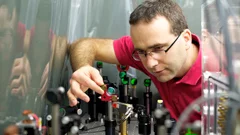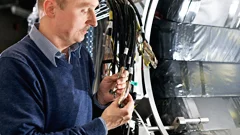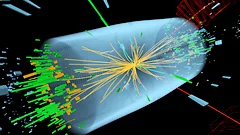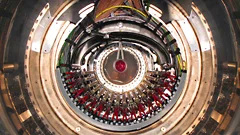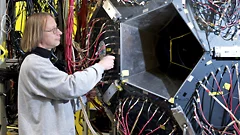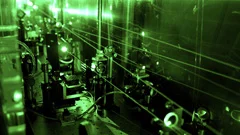Fundamentals of Nature
Researchers at the Paul Scherrer Institute PSI are looking for answers to essential questions concerning the underlying structures of matter and the fundamental principles of nature. They study the composition and properties of elementary particles – the smallest building blocks of matter – or investigate the structure of biological molecules and how they perform their function. The knowledge gathered in this way opens up new approaches to finding solutions in science, medicine and technology.
Find out more at Overview Fundamentals of Nature
Searching for the Higgs boson: PSI inside
Higgs Particle Found announced the media triumphantly in July 2012. But for Roland Horisberger, particle physicist at PSI, this was a premature conclusion: It will take at least another five years before we can be sure of that. Whatever the findings à whether this is the original Higgs boson, or only one of the theoretical Higgs-like particles à one can surely put a tag on them that reads PSI inside.
Proton size puzzle reinforced!
An international team of scientists confirmed the surprisingly small value of the proton radius with laser spectroscopy of exotic hydrogen. The experiments were carried out at PSI which is the only research institute in the world providing the necessary amount of muons for the production of the exotic hydrogen atoms made up of a muon and a proton.
The weak side of the proton
An international research team has determined with a high level of accuracy, how the proton participates in the weak interaction à one of the fundamental forces of nature. Their results confirm the predictions of the Standard Model of particle physics. The experiment observed the probability of muon capture by protons à a process governed by the weak interaction. The experiment was conducted at the Paul Scherrer Institute, the only institute in the world with an accelerator capable of generating enough muons for carrying out this project in a realistic timeframe.
Observation of a New Particle with a Mass of 125 GeV
In a joint seminar today at CERN and the ICHEP 2012 conference in Melbourne, researchers of the Compact Muon Solenoid (CMS) experiment at the Large Hadron Collider (LHC) presented their preliminary results on the search for the standard model (SM) Higgs boson in their data recorded up to June 2012.
Erkenntnis aus dem Nichts
Zwei Experimente mit massgeblicher Beteiligung von Forschern des Paul Scherrer Instituts PSI liefern wichtige Ergebnisse bei der Suche nach der richtigen Beschreibung der Welt der kleinsten Teilchen. In den Experimenten haben die Physiker nach sehr seltenen Teilchenzerfällen gesucht. In beiden Fällen konnte der gesuchte Zerfall nicht beobachtet werden wodurch bestimmte Modelle der Teilchenphysik ausgeschlossen werden konnten.This news release is only available in German.
How strong is the weak force?
A new measurement of the muon lifetime à the most precise determination of any lifetime à provides a high-accuracy value for a crucial parameter determining the strength of weak nuclear force. The experiments were performed by an international research team at the accelerator facility of the Paul Scherrer Institute.
Protons - smaller than we thought
The proton à one of the smallest building-blocks of all matter à is even smaller than had previously been assumed. This discovery is the result of experiments carried out at the Paul Scherrer Institute (PSI) in Villigen, Switzerland, by an international research team.
Technology from the Paul Scherrer Institute detects proton collisions at unprecedented levels of energy
CERN has been able to take the first measurements of collisions between the highest-energy particles ever generated. These collisions were performed at CERN's new LHC accelerator and recorded with the CMS Experiment, which involved a key component (the barrel pixel detector) contributed by the Paul Scherrer Institute in collaboration with Swiss Universities. The first LHC operation in Dezember 2009 has now resulted in a first particle physics publications of the CMS experiment. This is after a remarkable short time , given the compexity and the size of this gigantic experiment with over 3000 physicists and engineers from close to 40 countries.
Service to the scientific community
Neutrons, synchrotron light and muons are very useful for researchers in a variety of disciplines. Using these probes, we can determine the structure of crystals, they help us understand magnetic processes, or they can reveal the structures of biological materials. However, producing these probes is so difficult that most research groups will not have a neutron, muon or synchrotron light at their own scientific centre.

